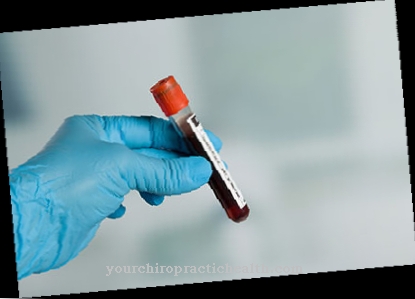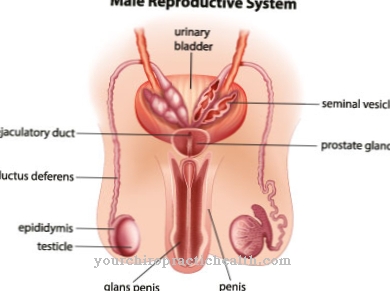cholera is a massive diarrheal disease that can lead to severe fluid loss. Cholera is caused by the bacterium Vibrio cholerae. Without treatment, cholera is mostly fatal.
What is cholera?

© Henrie - stock.adobe.com
The infectious disease cholera is a massive diarrheal disease. It is caused by the Vibrio cholerae bacterium and is fatal in 2/3 of all untreated cases. Cholera is mostly infected through contaminated drinking water. A person suffering from cholera suffers from this bacterial infection, above all, from enormous fluid losses due to constant diarrhea.
Cholera is often accompanied by nausea and vomiting, which can also lead to a loss of fluids and minerals (electrolytes). The mortality in cholera is therefore mostly due to kidney failure or circulatory collapse.
Today cholera occurs mainly in Southeast Asia, Africa and South America. Cholera cases are rarely reported in Germany, as the hygienic conditions in western industrialized countries are usually better developed. Nevertheless, it can happen that individual holidaymakers are infected with cholera and bring this disease to Germany and infect other people. Even the suspicion of cholera must be reported in the Federal Republic. If a cholera case occurs, it is immediately placed in quarantine treatment.
causes
As mentioned earlier, the main cause of cholera infection is the bacterium Vibrio cholerae. The risk of infection is particularly present in southern countries, the tropics or third world countries, as the hygienic conditions here are sometimes poor. The cholera bacterium can spread easily through animal carcasses and human corpses in rivers and lakes. Since these places are mostly used by the population for water supply, infection with cholera is quickly possible.
Vacationers from Europe can also get infected in these countries. Direct contact transmission of the pathogen from person to person is also possible. The incubation period, i.e. the time from infection to the onset of the disease, is usually a few hours, sometimes up to five days.
You can find your medication here
➔ Medication for diarrheaSymptoms, ailments & signs
A cholera infection often goes unnoticed since no symptoms are noticeable. About 80 to 90 percent of infections do not lead to any symptoms. If the cholera becomes noticeable, diarrhea occurs primarily. These can be quite harmless, but in severe cases can also be life-threatening.
The incubation period is two to three days. If the disease progresses mildly, the bacteria lead to mild diarrhea and abdominal cramps. If the disease is severe, severe diarrhea and vomiting set in. The stool is then very watery and is described as similar to rice water. This leads to a significant loss of fluid.
Patients can lose a liter of fluid per hour. The body becomes dehydrated, so it dries out. The mucous membranes become dry, body temperature and blood pressure drop. Often the face of the person concerned appears sunken. With the water, the body also excretes vital salts (electrolytes) such as sodium and potassium.
The result is an over-acidification of the body, which in turn can lead to muscle cramps. If there is no treatment with fluids and electrolytes, the kidneys fail. For severe cholera infections that are not treated, the death rate is around 50 percent. With appropriate therapy, however, mortality drops to below two percent.
course
Cholera can easily be confused with diarrhea or diarrhea if it has a mild course of disease. Nevertheless, the risk of infection for other people is considerably high. Cholera must be treated medically, as the mortality rate is extremely high even if the course is mild at first. Even with timely therapy, around one percent of those affected still die.
Complications
Cholera is a very serious disease that will definitely be treated by a doctor. If treatment is carried out too late or not at all, the disease usually leads to death. The outbreak of the disease itself only occurs in around 15 percent of cases of infection.
The incubation period is between two and three days, so that the person concerned usually does not notice at first that he is sick with the disease. In most cases, the symptom of cholera is vomiting diarrhea, which is often riddled with flakes of mucus. Abdominal pain rarely occurs.
Since a relatively large amount of fluid is withdrawn from the body during diarrhea, the patient also suffers from dehydration, which can be seen primarily through wrinkles and sunken cheeks on the face. The body responds to the disease through symptoms such as drowsiness, coma, adeptness, or a rash.
In most cases, treatment will be successful if the disease is discovered and treated in a timely manner. The body can defend itself against the infection, but needs a lot of nutrients due to the fluid loss. If left untreated, the disease is usually fatal, as has happened in many epidemics throughout history.
When should you go to the doctor?
Before going abroad in a country with poor drinking water and sanitation, a preventive cholera vaccination is indicated. If an infection is suspected, a doctor must be called in immediately. Typical warning signs include severe nausea and diarrhea as well as hoarseness, cramps and abdominal pain. The symptoms usually increase rapidly in intensity and ultimately cause circulatory shock and death of the patient.
Therefore, the person affected should go to the doctor at the first signs of illness. In particular, people who suffer from the symptoms mentioned after a trip to the tropics or third world countries should consult a doctor. The same is true if the symptoms are due to contact with someone who may be ill.
In any case, the complaints must be clarified if they have not subsided after three days at the latest or if they rapidly increase in intensity. Because of the high mortality rate and risk of infection, cholera must be clarified immediately and treated in hospital. In the event of impaired consciousness or a circulatory collapse, the emergency doctor must be alerted immediately.
Doctors & therapists in your area
Treatment & Therapy
Cholera needs urgent medical treatment to minimize mortality. In addition, cholera must be reported so that non-treatment can be prosecuted. The doctor can use the laboratory to determine the cholera pathogen in the stool or vomit of the person affected.
This is followed by the rapid use of fluids with electrolytes or sugar during cholera therapy. This is usually done as an inpatient and under quarantine in a hospital. The fluid lost through diarrhea and vomiting is compensated with the help of infusions. Up to 7 to 10 liters per day can be lost in body fluids in cholera, so this amount has to be administered again.
In addition to the infusions, antibiotics are integrated into the treatment for cholera. Its main purpose is to kill bacteria in the gastrointestinal region.
Outlook & forecast
The prognosis is very good with well-treated cholera. If the patient is provided with sufficient fluids and nutrients, it can be assumed that he will survive the most severe part of the infection within a few days and ultimately be considered healthy. However, his stool can still contain the pathogen weeks later, which is why caution is advised here. It is crucial for the success of the treatment that treatment is started as early as possible - i.e. before life-threatening dehydration of the person concerned.
If left untreated, however, up to 70 percent of those with cholera die. It mainly affects malnourished and immunocompromised people and those who can no longer take care of themselves due to the disease. Death usually occurs as a result of an insufficient supply of the brain or an organ failure.
Despite the fact that there is an oral vaccination for cholera, it is mostly hardly available in the areas affected by cholera. In addition, once overcoming cholera does not protect against further cholera infections. Despite the practical eradication of cholera in many parts of the world, foci of infection keep flaring up, leading to epidemics. Since cholera is very contagious and especially benefits from poor hygiene conditions, it will continue to exist in structurally weak areas.
You can find your medication here
➔ Medication for diarrheaAftercare
After completing the initial cholera therapy, extensive follow-up care is required. The administration of fluid and electrolyte replacements must be continued. The patient must consult the family doctor at regular intervals. A longer hospital stay is necessary if the course is severe.
Then rest and take it easy, as the disease can put an enormous strain on the body. Further medical examinations are part of the aftercare to rule out complications. It must also be ensured that the cholera pathogen has been completely flushed out of the body.
Affected children must take zinc supplements in the weeks and months after the treatment and also take it easy. While many cases of cholera can be treated, the long-term effects on physical health are many. Comprehensive aftercare is all the more important. Patients in hygienically underserved areas should leave the region if possible.
Vacationers who are sick with cholera after returning from a risk country must comply with the medical guidelines regarding the intake of medication and food supplements as part of the follow-up care. If there are no further complications or symptoms, treatment for cholera can be completed. Further aftercare measures are not necessary after recovery.
You can do that yourself
Since cholera is a potentially life-threatening disease, under no circumstances should measures be taken alone. Instead, the patient has to seek medical treatment during the illness, which usually requires a stay in hospital. In doing so, the person concerned has to follow all the instructions of the medical staff, otherwise their life is in danger.
In order to promote the healing process, all medical preparations must be taken as prescribed. In the treatment of cholera, the most important role played by regular fluid replacement is to prevent further dehydration. The doctor decides at what intervals and in what form they should be taken. Infusions and drinking solutions are available, and the patient must follow the respective instructions.
In addition to hydration, physical restoration plays an important role in recovery. Patients therefore keep physical activities to a minimum. With regard to food, particular attention is to be paid to hygiene, whereby mostly only meals tailored to the impaired digestive activity are considered. In order to quickly regenerate the gastrointestinal tract after the illness, patients follow the medical advice and use suitable preparations to rebuild the intestinal flora.


.jpg)


.jpg)
.jpg)






.jpg)

.jpg)
.jpg)











.jpg)